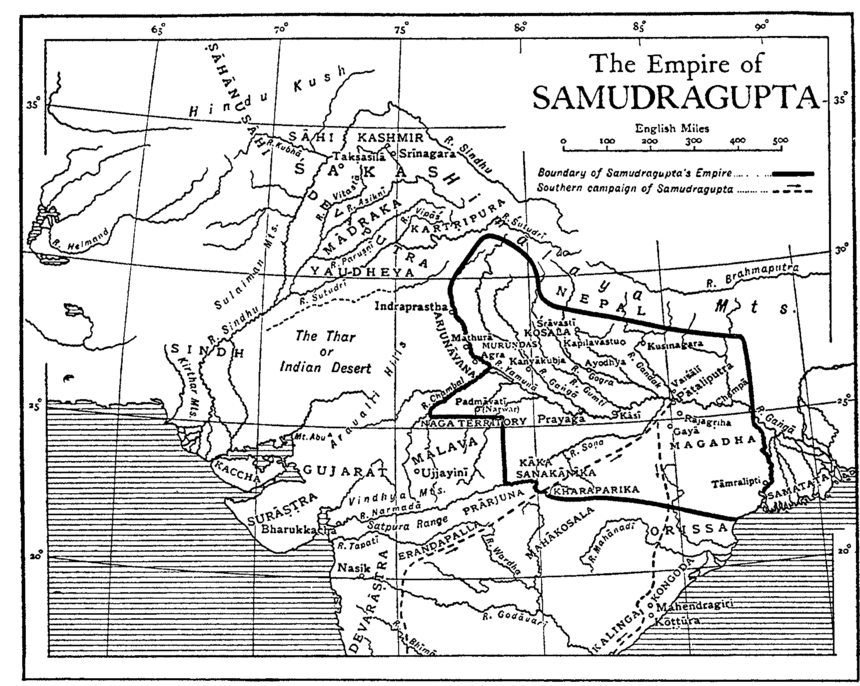
From Men and Thought in Ancient India, by R. Mookerji. Macmillan and Co., Ltd., 1924.
THE history of the Deccan begins several centuries after that of Gangetic India and therefore still longer after that of the Punjab. The Indo-European conquest advanced eastwards before it moved downwards into the southern peninsula.
The conquerors worked along the coasts, and also went overland. We have seen that in Asoka's time Kalinga was conquered, on the Bay of Bengal (261 B.C.). Beyond Kalinga lay Telugu-speaking peoples, who occupied the deltas of the Godavari and Krishna (Kistna). Even before the death of the great Buddhist emperor this region, which Megasthenes already knew for its wealth, became the kingdom of the Andhras, which was at first tributary to Asoka and afterwards independent. It so grew in power that it even stretched beyond the Western Ghats, where its two rivers rose to the coast of the Indian Ocean, cutting right across the peninsula from east to west. So a rivalry arose between this kingdom and that of the Kshatrapas for the possession of the part of the west coast which was provided with ports and commercial outlets. The Andhra dynasty covers about four centuries, roughly from 230 B.C. to a.d. 225. At first the capital was at Amaravati on the lower Krishna, but about a.d. 100 Sri Pulumayi established his government at Pratishthana (Paithan) on the upper Godavari. The dynasty reached the height of its glory in the reign of Gautamiputra Yajña Sri, about the middle of the second century; he annexed the state of the Kshatrapas, but for a few years only. Possibly this king, who is also known as Satakarni I, was the inaugurator of the heroic Vikrama era, famous in native tradition; but in that case this Satakarni must be placed in the first century, and the era would begin in A.D. 58.1
Let us pass into the opposite camp, that of the Kshatrapas or Satraps. This title, which is Iranian, is borne by two dynasties founded by the Sakas who had been driven from their country by the Yueh-chi invasion. The first was established in Surashtra (Kathiawar). One prince of this line, Chashtana, seems to have held Malwa before the great days of the Kushans and to have become a vassal of Kanishka; he ruled over Ujjayini, which was the centre of a brilliant civilization. The second line, to which the name of Kshaharata is more particularly attached, was the hereditary foe of the Andhras; it ruled over Maharashtra, the country between modern Surat and Bombay. Menander, the Greek King of Kabul, had advanced as far as this in the middle of the second century B.C. The country owed its wealth to its many ports, which were all the more valuable since the coast became inhospitable further south. There were Bharukachchha (Broach) at the mouth of the Narbada, Surashtra (Surat) at the mouth of the Tapti, and Surparaka (Sopara). Navigation between India and Ptolemaic Egypt had increased since the first century after Christ, when the art of making use of the monsoons had spread in the West. It was this latter Saka state that was annihilated by Satakarni, and it was the former which avenged it, when Rudradaman, the Satrap of Ujjayini, conquered the Andhra king.
The antagonism between the eastern and western states seems to have been accompanied by a difference of ideals. The Sakas, like all the Scythians of India or Serindia, such as the Tokharians, retained from their foreign origin a sympathy for Buddhism, which was a universal religion, whereas the Andhras were keen supporters of Brahmanism. But we should not make too much of this antithesis. Ujjayini was a great Buddhist centre, but orthodoxy so developed there that the kingdom of which it was capital was the first to write inscriptions in Sanskrit instead of the old Prakrit.
In the extreme south of the peninsula there were several seaboard towns which were in communication with the China seas and with the West. From the Pandya country, for example, opposite Ceylon, a mission was sent which was received by Augustus in 20 B.C. The Chola kingdom was predominant on the coast of Coromandel, and that of the Cheras or Kerala on the Malabar coast, its chief ports being
Muziris (Cranganore) and Bakarai (in Travancore). The nations of Coromandel reached a high degree of prosperity in the first three centuries of our era, as is proved by the development of Tamil literature, especially at Madura. Most of them were divided by a permanent enmity from the people of Ceylon, where Buddhism had prevailed since the mission of Asoka.
1 Not in 58 B.C., as was supposed by Vincent Smith (LXXIVa, p. 151).